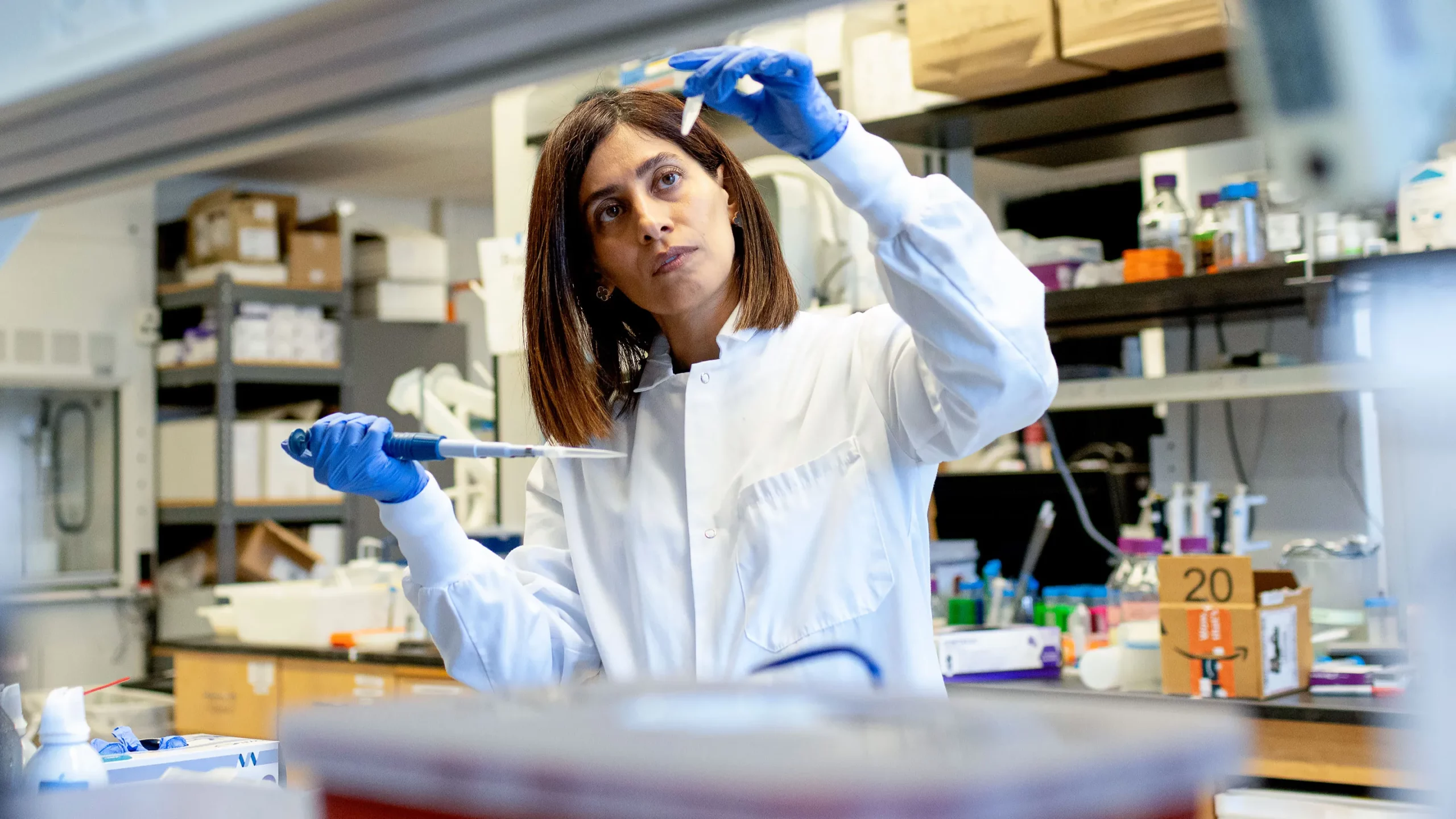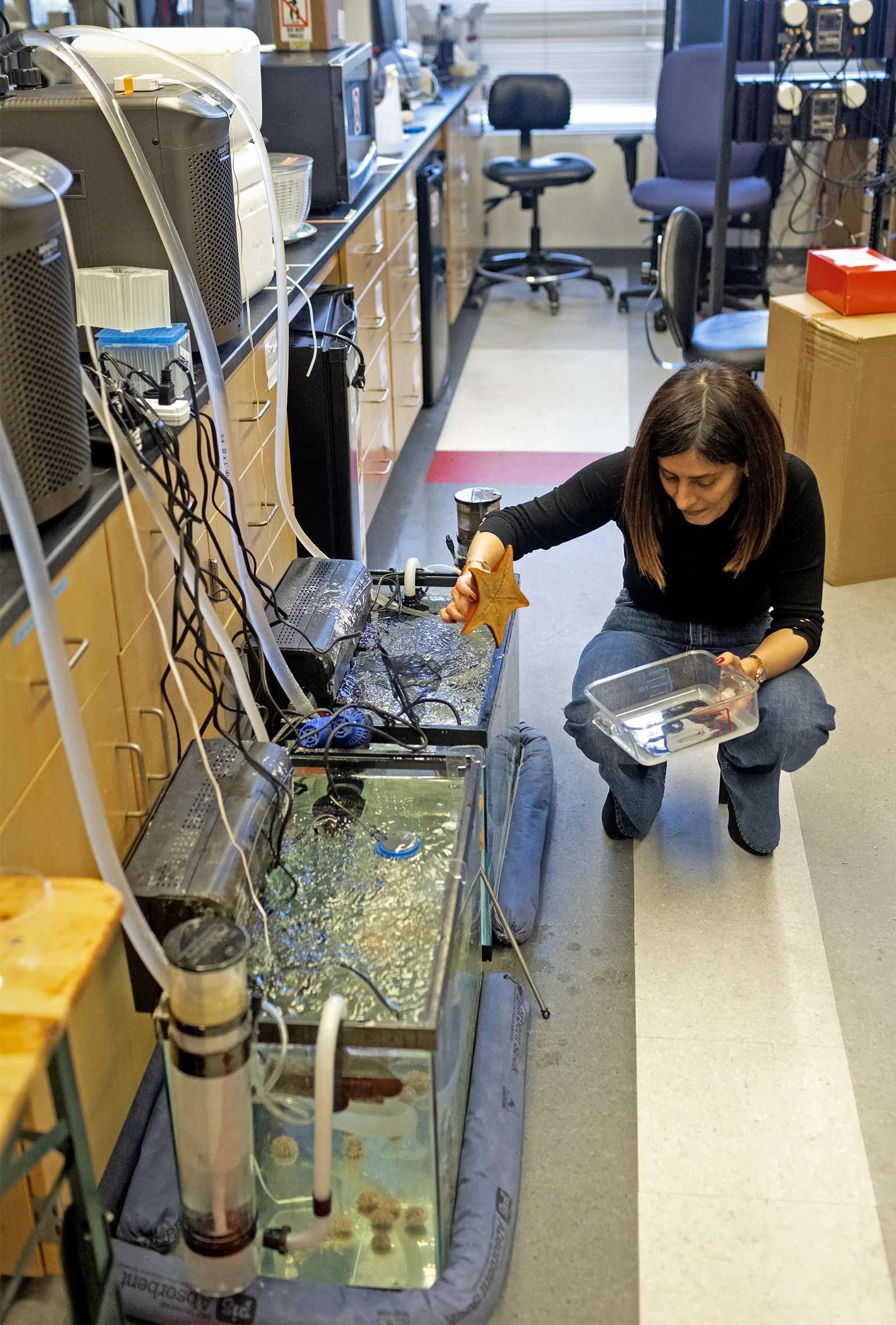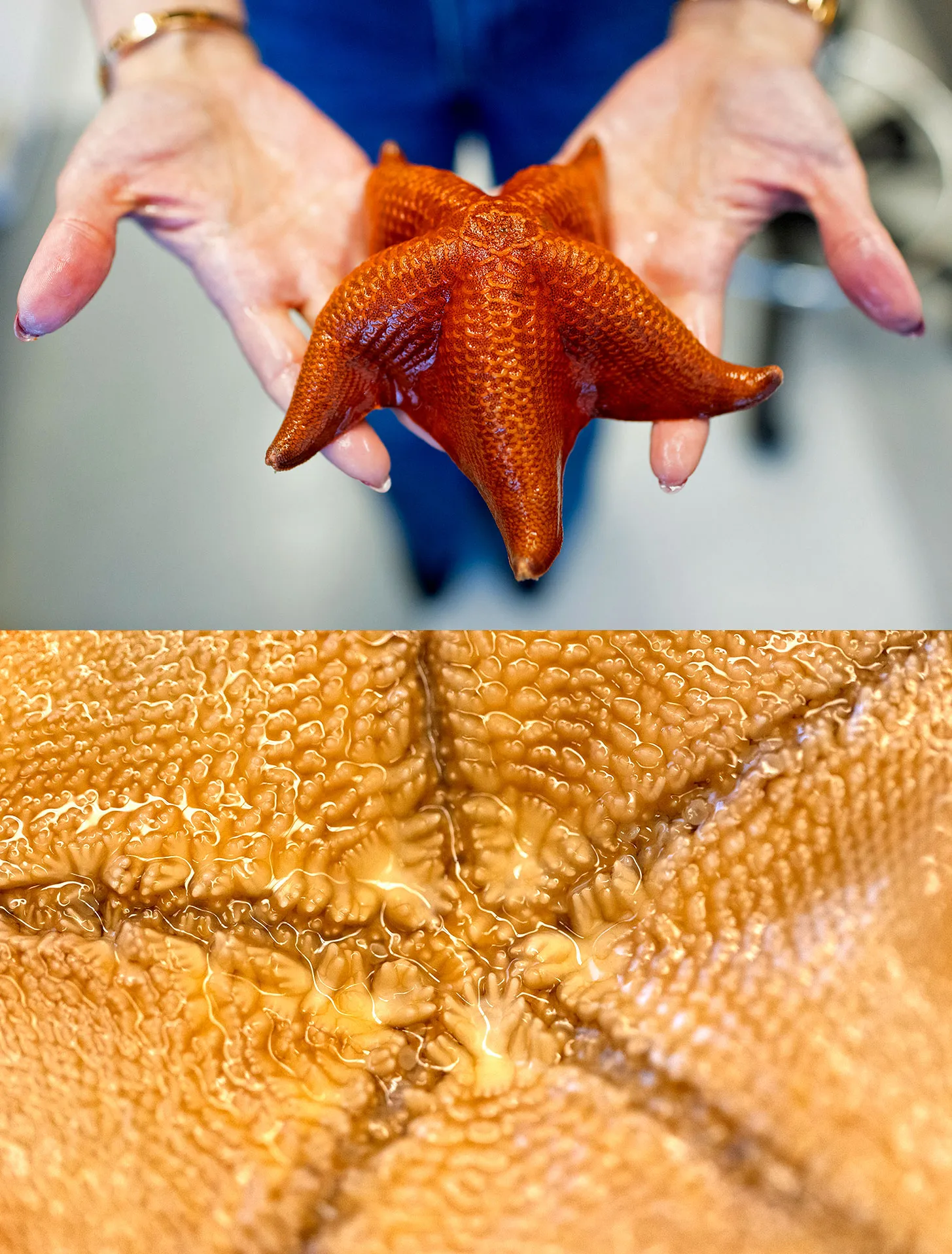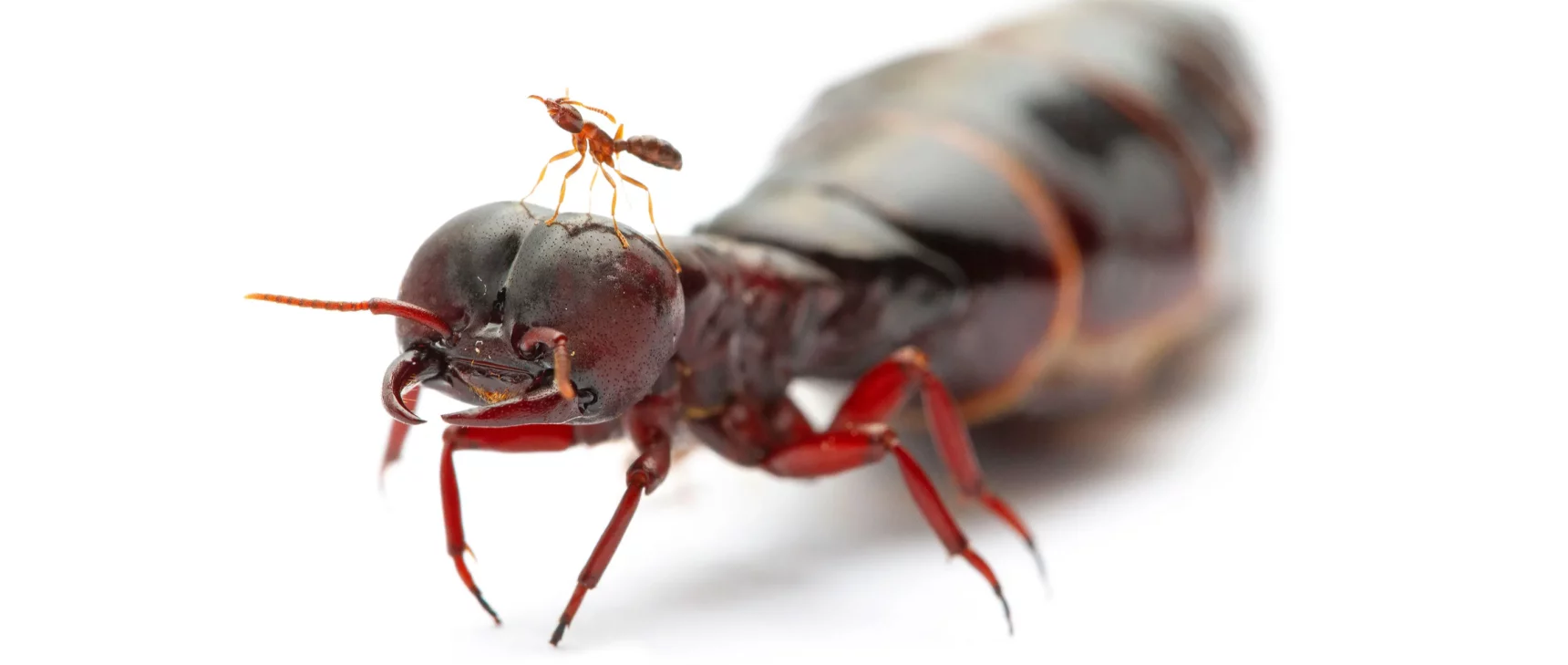Starfish Whisperer Develops a Physical Language of Life

Nikta Fakhri sees the world of biology through a physicist’s eyes.
Katherine Taylor for Quanta Magazine
Introduction
In a sunny lab at the Massachusetts Institute of Technology, two starfish fought over their prey. Overlapping arms pinned a hunk of thawing cocktail shrimp against the side of the tank. Thousands of suction cups rippled furiously against the glass as each echinoderm struggled to inch the prize toward its own maw.
The physicist Nikta Fakhri looked on with a grin. Not many physicists keep ocean life in their labs, but Fakhri has learned to care for starfish nearly as well as a marine biologist would. And now she’s expanding her menagerie; when a reporter visited recently, a couple of tanks awaited the imminent arrival of sea urchins.
Fakhri has turned to echinoderms in the hope of answering an age-old question: What is life? Or, in one modern formulation: How do the microscopic operations of proteins and cells add up to a clash between hungry starfish?
In the quest to understand how the turning of biological gears produces the unspeakably complex business of living, Fakhri found it natural to turn to physics — a field that’s adept at linking microscopic and macroscopic phenomena. Physicists have learned that temperature emerges from the motions of molecules, magnetism from the orientations of atoms, and superconductivity from the pairing up of electrons. Perhaps life, too, can be elegantly described as a property that can emerge under the right circumstances.
But which circumstances?
By scrutinizing starfish embryos, Fakhri has made strides toward accounting for those circumstances using concepts from physics. She notes that, like other states of matter, life “breaks symmetry” — the growth of an embryo distinguishes its past from its future, for instance. Fakhri has extended the language of symmetry-breaking to describe how proteins and other tiny biological components conspire to enable movement, reproduction and other hallmarks of life. Along the way, she has observed a bizarre new state of matter that may help life influence its surroundings.
Fakhri grew up in Tehran, Iran. Despite the oppressive environment for women, her parents supported her education, and she eventually made her way to leading institutions abroad. Last year, the American Physical Society recognized her with its Early Career Award for Soft Matter Research, for “groundbreaking and inspiring developments.” Quanta’s recent conversation with Fakhri in her lab on the MIT campus has been condensed and edited for clarity.
What’s the problem with biology, and how might physics help?
Biology is a field that’s really defined by its molecules. It has been very successful at identifying the components and microscopic mechanisms of life. Of course, knowing the details is important, but there’s still a big gap between understanding how, say, a protein consumes energy and understanding how putting all these parts together adds up to lifelike behavior.
Physics takes a somewhat different view. We want to understand the principles that explain things across various scales, from the very small to the very large, using a sort of universal language. For example, we once thought of heat as a fluid. But with thermodynamics, we were able to account for temperature as the movement of molecules.
In the case of life, we would like to know: How do you go from energy dissipation at a single-particle level all the way up to a flock of birds?

Fakhri chose starfish embryos as her model organism because of the many ways they break symmetry. She has recently started studying sea urchins as well.
Katherine Taylor for Quanta Magazine
That seems like a lofty target, given that a bird is vastly more complicated than a molecule. Could ideas as simple as those that have defined temperature really be usefully applied to living organisms?
Life is undoubtedly complex beyond what we’re used to in physics, but I think that’s an exciting challenge. In the past, physics has shown that this approach of trying to understand a unit as more than the sum of its parts is at the heart of many complex phenomena. I would like to be optimistic that physical rules may allow us to understand what might be the ultimate complexity in the world.
What’s the primary challenge in developing a physical framework for life?
In physics, we need a system to be at equilibrium to define just about anything. Equilibrium is what lets us understand the pressure of a gas just by knowing the number of molecules in a box, without worrying what kind of molecules they are or what the box is made of. It’s an incredible achievement that we often take for granted. But life is not in equilibrium. There’s a famous saying that when a living system reaches equilibrium, it’s dead. With life, there’s a constant shifting between different types of stability — like how you go from awake to asleep and back to awake again. We need to develop ways of understanding how a living system changes from one such steady state to another.
This accounting can also enrich physics. Physics has been very successful, but it isn’t really equipped to handle the nonequilibrium nature of living systems.
What sort of framework might be able to handle life’s constant changes?
The key to understanding transitions from one state of a system to another is symmetry-breaking. The classic example is a metal becoming magnetized. Initially, you have particles pointing every which way — the metal has “rotational symmetry” because every direction looks the same from the point of view of a particle. Then you switch on a magnetic field and suddenly all the particles orient in one special direction, breaking the symmetry.
You can then define what’s called an order parameter, which is an important way of going from one particle to a description of many particles. In a magnet, the order parameter is the arrow at each point telling you in what direction a bunch of nearby particles are pointing on average. The order parameter allows you to understand what the broken symmetry is and what happens during a transition. But finding the right order parameter is an art.
That’s a big part of what we’re trying to do with our model system, starfish egg cells. We describe the ways they change in terms of order parameters and broken symmetries.


While their embryos start out round, starfish break that rotational symmetry and end up with a five-pointed pentameral symmetry (top). The underside of a starfish hides thousands of suction cups and a central mouth.
Katherine Taylor for Quanta Magazine
While their embryos start out round, starfish break that rotational symmetry and end up with a five-pointed pentameral symmetry (left). The underside of a starfish hides thousands of suction cups and a central mouth.
Katherine Taylor for Quanta Magazine
Why starfish egg cells?
A physics approach requires model systems with rich behavior and self-organization on different scales. When I joined MIT, there was a group in the biology department that was thinking about starfish as a model system. As we talked, it became more and more clear to me that it had everything we needed.
Now I’m even more convinced. This summer, I spent some time at the Marine Biological Laboratory in Woods Hole. Starfish are echinoderms, and we played with other echinoderms like sea urchins and sand dollars. I was just blown away by the beauty of marine life, and how all echinoderms go from this round, symmetrical egg cell to a pentameral broken symmetry. Just this tiny branch of life has so much symmetry-breaking to study.
So how does symmetry-breaking define life?
The most important broken symmetry is time.
I always start my talks with a video of an embryo developing, but I play it backward. When I show it to biologists, right away they’re like, “This isn’t right. Cells never merge.”
Zoom in, however, and the arrow of time isn’t so sharp. As a postdoctoral researcher, I studied the motions of carbon nanotubes inside human cells. To the naked eye, their jiggling looks random, the same whether you play the video forward or backward. But when we measured the jiggling of the nanotubes in detail, the fluctuations seemed to be much higher than what you’d expect to see in equilibrium at room temperature. They moved as if the cell had a temperature of 1,000 degrees. Where were these extra fluctuations coming from? They had to be related to the fact that, unlike a magnet at equilibrium, the cells were continuously consuming energy and using it to live, to establish an arrow of time.
That work opened up my whole world to these amazing nonequilibrium systems, and I dove deeper into biophysics.

Fakhri uses ideas from physics, such as the way magnetism emerges from atoms, to understand how life emerges from molecules like proteins.
Katherine Taylor for Quanta Magazine
So equilibrium systems fluctuate in random ways that, on average, don’t add up to meaningful change. But nonequilibrium systems like living things can fluctuate in more organized patterns — and the seeds of that organization must exist even at the microscopic level, even if everything looks random down there. Were you able to spot those seeds of coordination?
In another project, I studied the vibrations of cilia around kidney cells. Cilia are the little hairs that cells use to swim or sense their environments, and they also vibrate in a way that looks random. But we found that if you break their vibrations down into a few basic moves, we could identify a repeating pattern — a cycle — in how each cilium was mixing up the basic motions.
That kind of cycle is a telltale sign that your system is not in equilibrium, that it has an arrow of time. We later learned how to use the direction and size of the cycle to figure out how far the cells were out of equilibrium.
You also use symmetry-breaking to understand how starfish embryos grow.
Egg cells split over and over again as they grow into an embryo, and each division is a spectacular example of symmetry-breaking in both time and space. Somehow tiny proteins tell the gigantic cell when and where to start dividing. To a protein, any spot and any moment is as good as another. So how do they break symmetry so that the cell divides here and now?
Well, how do they?
There’s a key signaling protein, called Rho-GTP, that tells the cell’s “muscles” to contract and transmit a force that leads to cell division. When we tracked how many of these proteins were switching on during cell division, we saw that their activity levels took the form of these ripples spreading across the entire surface of the cell. The question was: How could we characterize these ripples? What’s their order parameter?
We found that if we recorded a movie of the ripples and zoomed in on just one pixel, its brightness rose and fell like a wave. The neighboring pixel did too, but its wave was a little out of step with the first one. After some trial and error, we chose to use how much these two waves were out of step as our order parameter.
Here’s where it gets interesting. We found that there were spots where the wave just stops. Now, I love this. These spots behave exactly like charged particles, which physicists have lots of experience with. It’s as if they had a charge of plus or minus 1 depending on whether they rotate clockwise or counterclockwise. Sometimes oppositely charged pairs get created, and sometimes they annihilate each other. Now we have this whole language to explain how this system is self-organizing in space and in time. We believe that these particles are the organizing centers of force generation. They control the properties of the waves that tell the cell when and where to divide.
You’ve used physics to understand what’s going on in a cell. Have you moved to the level of multicellular organisms?
If you let the cells keep dividing, you basically get this arrow of time progressing. Eventually you have millions and millions of cells forming one starfish embryo. The embryo has cilia, and at some point the cilia start beating synchronously and the embryo starts swimming around. It swims in a spinning, corkscrew motion that can attract other spinning embryos.
One morning we came into the lab, and my students noticed that a bunch of embryos had clumped together on the water’s surface. And the clusters — which we came to call “living crystals” — were also spinning around, breaking the symmetry between the clockwise and counterclockwise directions. This system has so many types of symmetry-breaking!
What could you learn from these living crystals?
When you point a camera down at the crystal and spin it at the same speed so you can’t see the rotation, you can see that the whole crystal seems to be gently jiggling with slow ripples.
At the same time we were studying this, Vincenzo Vitelli’s group in Chicago was working on a theory where basically you have two particles with internal batteries that spin relative to each other. These particles can actually defy Newton’s third law of motion: There is no equal action and reaction. The first particle affects the second one differently than the second one affects the first.
If I have a material made of these rotating particles, called an “odd” material, when I push on it, the unbalanced interactions between particles make the material rotate. It’s like you have a top and when you push down it starts spinning. The Chicago group predicted that under certain conditions these rotations could sync up to create sustained oscillations.
This investigation of odd materials in living systems was all theoretical until we showed that with our crystals of starfish embryos, which burn energy to spin in a similar way, you can really get these sustained oscillations.
Do starfish embryos use this odd property to do anything useful?
Maybe! Starfish spawn in tide pools where the temperature changes a lot. So one idea is that the embryos come together just like a flock of birds and use their collective behavior as a way of heating or cooling their environment, by directing the flow of energy.
What’s the significance of this discovery?
We built a crystal out of biological particles and got something that has never been seen before, which opens up a range of new questions.
For instance, we always thought about cells as having equilibrium properties with some activity. But what if the system is first and foremost defined by its out-of-equilibrium activity, as these odd materials are? The cells are using this oddness, maybe to keep themselves cool. What if other living systems also exploit properties like oddness for basic functions? What if you need this framework to understand how muscles work?
Another question is: What materials might we be able to build once we understand better how living materials work? Right now, we are bound by the physical laws that we know. But maybe this kind of research can give us a big jump in what kinds of functions we can get materials to perform.
The next big step will be whether we can make a connection between the quantities we’ve learned to measure and biological functions. One defining feature of living systems is they have a purpose. In the coming years, my dream is to connect particular functions, say a specific type of cell mobility, with numbers we can measure, like energy dissipation. Finding this kind of connection is a much bigger goal.



